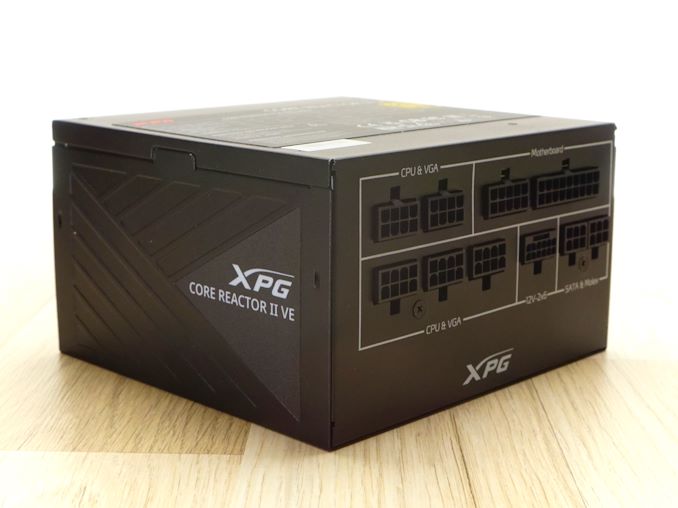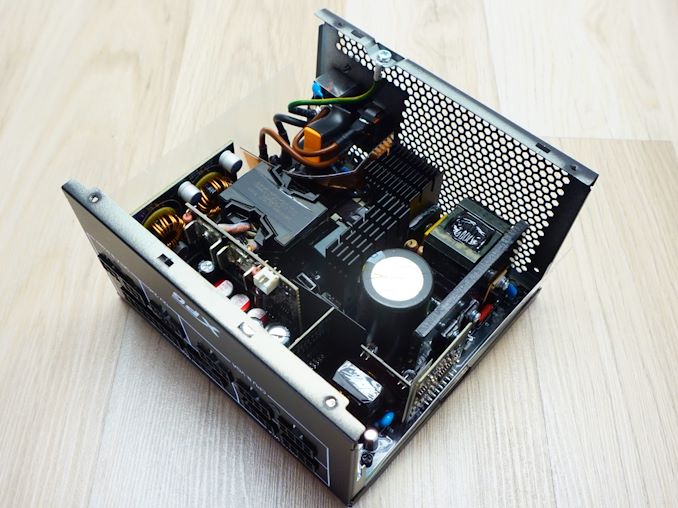The XPG Core Reactor II VE 850W PSU Review: Our First ATX 3.1 Power Supply
by E. Fylladitakis on May 2, 2024 10:00 AM EST- Posted in
- Cases/Cooling/PSUs
- PSUs
- 80Plus Gold
- XPG
- ATX v3.1
Power Supply Quality
The electrical performance of the XPG Core Reactor II VE 850W PSU is competent, with effective voltage regulation across its outputs. However, ripple suppression on the 3.3V and 5V lines shows room for improvement, characterized as mediocre compared to industry leaders. The 12V rail exhibits a maximum ripple of 56 mV, and the ripple on the 5V and 3.3V lines measures at 38 mV and 34 mV respectively, indicating less stringent control compared to some high-end models. Despite this, the PSU maintains stable operation and matches the performance ratings advertised by the manufacturer.
| Main Output | ||||||||
| Load (Watts) | 172.03 W | 429.42 W | 642.42 W | 855.98 W | ||||
| Load (Percent) | 20.24% | 50.52% | 75.58% | 100.7% | ||||
| Amperes | Volts | Amperes | Volts | Amperes | Volts | Amperes | Volts | |
| 3.3 V | 1.99 | 3.3 | 4.97 | 3.3 | 7.45 | 3.28 | 9.94 | 3.28 |
| 5 V | 1.99 | 5.06 | 4.97 | 5.05 | 7.45 | 5.04 | 9.94 | 5.04 |
| 12 V | 12.79 | 12.15 | 31.98 | 12.13 | 47.97 | 12.1 | 63.96 | 12.09 |
| Line | Regulation (20% to 100% load) |
Voltage Ripple (mV) | |||||
| 20% Load | 50% Load | 75% Load | 100% Load | CL1 12V |
CL2 3.3V + 5V |
||
| 3.3V | 0.5% | 14 | 24 | 30 | 34 | 18 | 32 |
| 5V | 0.3% | 12 | 20 | 26 | 38 | 16 | 28 |
| 12V | 0.5% | 16 | 26 | 32 | 56 | 48 | 30 |
During our thorough assessment, we evaluate the essential protection features of every power supply unit we review, including Over Current Protection (OCP), Over Voltage Protection (OVP), Over Power Protection (OPP), and Short Circuit Protection (SCP). The XPG Core Reactor II VE 850W PSU passed all critical protection tests, proving its capability to safeguard against scenarios that could compromise the PSU or connected components. The unit showed slightly loosely calibrated Over Current Protection (OCP) for the 3.3V and 5V rails, activating at 136% and 138% respectively, which is high but remains within acceptable limits. The 12V rail’s OCP activation at 146% is extremely high but we are not surprised considering the need of manufacturers to comply with the power excursion design guide requirements.
Conclusion
The XPG Core Reactor II VE 850W PSU distinguishes itself as the first ATX 3.1-compliant unit from XPG, setting a benchmark in the power supply landscape with its adherence to the latest standards. Priced at an MSRP of $119 and likely to retail for significantly less, this power supply unit blends high-quality performance, robust construction, and a price point that appeals to a broad spectrum of users. Manufactured by the reputable Channel-Well Technologies, the unit benefits from expert craftsmanship, enhancing its durability and ensuring it stands up to the rigors of daily use. The provision of a 7-year warranty by XPG further emphasizes their confidence in the PSU's long-term reliability.
In terms of performance, the XPG Core Reactor II VE 850W does very well, achieving impressive efficiency ratings that greatly exceed the requirements for 80Plus Gold certification, recording average nominal load efficiencies of 90.9% on 115 VAC and 91.7% on 230 VAC. Power quality is great too, with fantastic voltage regulation on all lines and good filtering on the primary 12V line. Despite its strengths, it is worth mentioning that the unit does exhibit only moderate ripple suppression on the 3.3V and 5V lines, which may be adequate but not on par with other high tier products.
Thermal management in the Core Reactor II VE is acceptable, mostly thanks to its powerful 120 mm fan, which effectively dissipates heat across varying loads. However, the unit's electrical performance does show signs of degradation under extreme conditions due to thermal stress, particularly when operating near full capacity in higher ambient temperatures. This aspect is crucial for users to consider, especially those in warmer climates or with high-load applications, as it impacts both performance and noise levels, with the latter increasing significantly under heavy loads.
In conclusion, the XPG Core Reactor II VE 850W PSU is a significant release, being the first to meet ATX 3.1 specifications, seemingly offering forward-looking compatibility with next-generation hardware. The balance of cost, capabilities, and the extended warranty make it an attractive option for a wide range of users, from gamers to professional workstation builders. While it performs admirably across most parameters, potential buyers should weigh the implications of its poor performance under adverse operating conditions. Still, its performance metrics under typical operating conditions and quality make it a worthy investment for those who want a balanced product that does not break the bank.












31 Comments
View All Comments
Dante Verizon - Thursday, May 2, 2024 - link
These tests confirm what I always say: buy a PSU with 20% more power than recommended for your system.You'll have a safety margin, the PSU will work cooler, quieter and should even last longer
haukionkannel - Thursday, May 2, 2024 - link
So this is the first psu with somewhat fixed 12 pin power connectors. What gpus have now? These new connectors aka do we see improved safety from now on….Ryan Smith - Thursday, May 2, 2024 - link
GPUs have already started using the revised connector. PSUs take a bit longer to spin up, both because they don't sell through as quickly, and because there are material changes to power delivery in ATX 3.1 that had to be accounted for.Samus - Tuesday, May 7, 2024 - link
Are these HP12V connectors backwards compatible with one another between cards, cables and PSU's?flgt - Thursday, May 2, 2024 - link
I’m know it’s tough with all the legacy hardware, but they really need to go the 48 VDC at this point if they are writing new specs.Railgun - Thursday, May 2, 2024 - link
What?zodiacfml - Friday, May 3, 2024 - link
I like 48V but that would require change across the industry, like datacenters and more. Tesla is likely to go this route, they already announced a revolutionary datacenter years ago for efficiency.meacupla - Friday, May 3, 2024 - link
The thing is though, 48V isn't all that efficient due to CPU/GPU/DRAM etc. all wanting 1.1~1.5V.The larger the step is, the less efficient the conversion becomes.
Laptops have this all figured out already, and 19.5~20V has the best power efficiency.
USB-C PD allows up to 240W (48V, 5A), but no one has bothered to implement this on either end.
There are no laptops with 240W USB-C input, and no chargers that do 48V, 5A output. The only 240W PD parts out are cables.
The reason being the above mentioned efficiency loss when stepping down the input voltage.
Scabies - Friday, May 3, 2024 - link
Framework 16 allows 240W charging. Admittedly, their best GaN adapter tops out at 180W.zodiacfml - Saturday, May 4, 2024 - link
I think conversion losses is even or same for specific target chip voltages. Actually, many modern PSU designs steps up voltages from the power outlet to insane numbers so that losses and AC transformer size required is minizmied then step down the voltage through solid state components or DC converters.